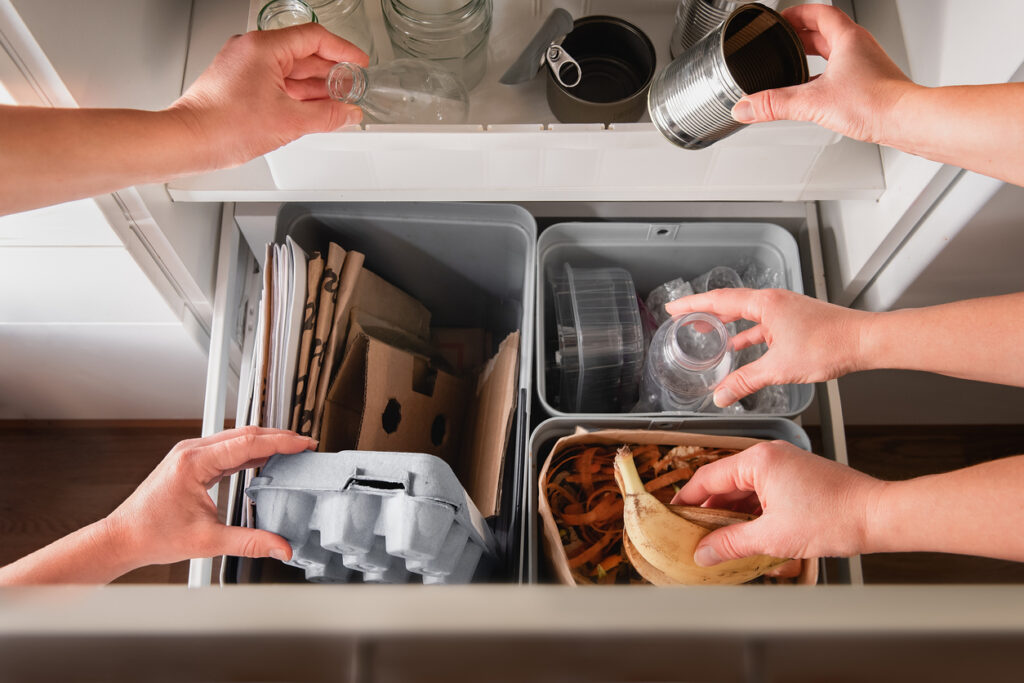How to Fix Minor Light Switch Issues: Step-by-Step Guide
Fixing minor light switch issues promptly can prevent further electrical hazards and maintain your home’s functionality. This guide will provide…
Read More
In today’s world, where environmental concerns are increasingly important, adopting sustainable practices in our daily lives has become crucial. Three key concepts that play a significant role in minimizing our environmental impact are reuse, reduce, and recycle. By understanding these concepts and incorporating them into our homes, we can make a positive difference for the planet. In this article, we will explore what reuse, reduce, and recycle mean and provide practical tips on how to incorporate these processes into your home.

Reuse refers to using an item multiple times or finding new purposes for it instead of throwing it away. By reusing items, we can reduce waste and conserve resources. Reusing not only helps the environment but also saves money. Here are some ways to incorporate reuse in your home:

Reduce focuses on minimizing the amount of waste generated in the first place. By reducing consumption and being mindful of our choices, we can decrease our environmental footprint. Here are some tips to incorporate reduction practices in your home:

Recycling involves transforming waste materials into new products to conserve resources and reduce landfill waste. Recycling helps divert materials from the waste stream and gives them a second life. To incorporate recycling in your home, follow these guidelines:
Incorporating reuse, reduce, and recycle processes into your home can be a rewarding and impactful journey. Here are some additional tips to help you get started:
Place designated recycling bins in convenient locations throughout your home to make it easy for everyone to participate in recycling efforts. Make sure to educate your family members about what can and cannot be recycled.

If you have a garden or outdoor space, consider starting a compost pile or using a compost bin. Composting helps reduce food waste and creates nutrient-rich soil for your plants.
Declutter your home and embrace a minimalist approach by keeping only the things you truly need or cherish. By reducing the number of possessions, you not only create a more organized living space but also reduce the consumption of resources.
Stay informed about environmental issues and share your knowledge with your family and friends. Engage in discussions about sustainability and encourage them to adopt environmentally friendly practices.
By embracing the concepts of reuse, reduce, and recycle in your home, you can make a positive impact on the environment. Start small, gradually incorporating these practices into your daily routines. Remember, every effort counts, and together we can create a more sustainable future for generations to come.
Fixing minor light switch issues promptly can prevent further electrical hazards and maintain your home’s functionality. This guide will provide…
Read MoreWorn-out weather stripping can lead to drafts, higher energy bills, and decreased comfort in your home. Understanding the common causes…
Read MoreRegularly inspecting your weather stripping is essential for maintaining an energy-efficient and comfortable home. This guide will walk you through…
Read MoreRemoving old, worn-out weather stripping is the first step in replacing it with new, effective sealing. This guide will provide…
Read MoreInstalling new weather stripping is essential for maintaining an energy-efficient and comfortable home. This guide will provide step-by-step instructions on…
Read MoreRegular maintenance of your weather stripping is essential for ensuring its longevity and effectiveness. This guide provides tips and best…
Read MoreFaulty smoke detectors can compromise your home’s safety and put you at risk in the event of a fire. Understanding…
Read MoreReplacing faulty smoke detectors is essential for maintaining a safe home environment. This guide will provide step-by-step instructions on how…
Read MoreUpgrading to smart smoke detectors can enhance your home’s safety with advanced features and connectivity. This guide will provide step-by-step…
Read MoreRegular maintenance of your smoke detectors is essential for ensuring their longevity and effectiveness. This guide provides tips and best…
Read MoreRegularly inspecting your smoke detectors is essential for maintaining your home’s safety. This guide will walk you through the process…
Read MoreSelecting the right kitchen faucet is crucial for both functionality and aesthetics. With so many options available, it can be…
Read MoreReplacing your kitchen faucet can seem daunting, but it's a manageable task that can save you money and improve your…
Read MoreEven with the best instructions, problems can arise during a DIY project. This guide addresses common issues you might face…
Read MoreRegular maintenance is key to ensuring your kitchen faucet functions well and lasts long. This guide provides maintenance tips and…
Read MoreA Grandmillennial living room with a dusty rose tufted sofa, floral wallpaper, vintage decor, and a vintage chandelier, creating a…
Read MoreA Cafécore living room with exposed brick walls, wooden furniture, layered textiles, and a mix of vintage and modern décor,…
Read MoreAn opulent Dark Maximalism living room with deep colors, plush velvet seating, ornate gold-framed mirrors, and a rich tapestry, creating…
Read MoreRing Alarm Pro: OverviewThe Ring Alarm Pro claims to be a comprehensive home security system designed to provide robust protection…
Read MoreSamsung SmartThings Station: OverviewThe Samsung SmartThings Station claims to be a versatile and powerful smart home hub designed to unify…
Read MoreApple HomePod Mini: OverviewThe Apple HomePod Mini claims to be a compact and powerful smart speaker designed to bring high-quality…
Read MoreGoogle Nest Hub: OverviewThe Google Nest Hub claims to be a versatile smart display designed to serve as the central…
Read MoreAmazon Echo Dot: OverviewThe Amazon Echo Dot claims to be a compact and affordable smart speaker designed to bring the…
Read MoreEufy RoboVac 11S: OverviewThe Eufy RoboVac 11S claims to be a compact and budget-friendly robot vacuum designed to provide efficient…
Read MoreEcovacs Deebot T20 Omni: OverviewThe Ecovacs Deebot T20 Omni claims to be an advanced robot vacuum and mop combo designed…
Read MoreiRobot Roomba S9+: OverviewThis product claims to be a top-of-the-line robot vacuum designed to deliver exceptional cleaning performance and smart…
Read MoreRoborock S8 Pro Ultra: OverviewThis product claims to be an advanced robot vacuum designed to provide powerful cleaning performance and…
Read MoreLevel Lock Touch: OverviewThe SwitchBot Lock claims to be a sophisticated smart lock designed to blend seamlessly with your existing…
Read MoreUltraloq U-Bolt Pro: OverviewThe SwitchBot Lock claims to be a versatile and highly secure smart lock designed to offer multiple…
Read MoreSwitchBot Lock: OverviewThe SwitchBot Lock claims to be a versatile smart lock designed for renters and homeowners seeking an easy-to-install,…
Read MoreWyze Lock: OverviewThe Wyze Lock claims to be an affordable and versatile smart lock designed to offer enhanced security and…
Read MoreSchlage Encode Smart Deadbolt: OverviewThe Schlage Encode Smart Deadbolt claims to be a top-tier smart lock designed to provide robust…
Read MoreYale Assure Lock SL: OverviewThe August Wi-Fi Smart Lock claims to be a sleek and modern smart lock designed to…
Read MoreAugust Wi-Fi Smart Lock: OverviewThe August Wi-Fi Smart Lock claims to be a state-of-the-art smart lock designed to provide enhanced…
Read MoreArlo Essential Video Doorbell: OverviewThis video doorbell claims to be a robust smart doorbell designed to enhance home security and…
Read MoreWyze Video Doorbell Pro: OverviewThis video doorbell claims to be an affordable and feature-packed smart doorbell designed to enhance home…
Read MoreGoogle Nest Doorbell: OverviewThis video doorbell claims to be an advanced smart doorbell designed to provide enhanced security and convenience…
Read MoreRing Video Doorbell Pro 2: OverviewThis video doorbell claims to be an advanced smart doorbell designed to enhance home security…
Read MoreAeotec Smart Home Hub: Overview This smart home hub claims to be a comprehensive solution for managing a wide range…
Read MoreRachio 3 Smart Sprinkler Controller: OverviewThis smart sprinkler controller claims to be an advanced irrigation controller designed to optimize your…
Read MoreNetro Sprite Smart Sprinkler Controller: OverviewThis sprinkler controller claims to be an eco-friendly irrigation controller designed to make garden and…
Read MoreOrbit B-hyve XR: OverviewThis sprinkler controller claims to be a state-of-the-art irrigation controller designed to enhance the efficiency and convenience…
Read MoreCreating a room around J.M.W. Turner’s "The Fighting Temeraire" allows you to infuse your space with historical significance and a…
Read MoreDesigning a room around an iconic piece of art can transform your space into a cohesive, aesthetically pleasing environment. Georges…
Read MoreFor those looking to invest in top-of-the-line smart home technology, the $500+ range offers advanced solutions that provide exceptional convenience,…
Read MoreIf you’re looking to make your home smarter and your budget is $500 or less, you’ve opened up more possibilities…
Read MoreIn today's connected world, smart home technology has become more accessible than ever. You don't need to break the bank…
Read MoreInvesting $500 or more into your living room allows for premium upgrades that transform the space into a luxurious and…
Read MoreIf you're ready to invest a bit more into revitalizing your living room, the $200 to $500 budget range opens…
Read MoreThe living room is often the heart of the home, hosting everything from casual family gatherings to formal guests. Over…
Read MoreTransforming your home with inspiration from modern art allows for a creative and expressive interior design. For this practical guide,…
Read MoreSelling your home can be a daunting task, but with a few tweaks you can enhance its appeal and increase…
Read MoreThe dining room is not just a place for eating; it's a venue for making memories, from daily family dinners…
Read MoreThe dining room, a hub of family gatherings and festive celebrations, often holds sentimental value, making it a pivotal space…
Read MoreThe dining room is a special place in any home—a space where meals are enjoyed, conversations flow, and memories are…
Read MoreOur bedrooms serve as private refuges, where we retreat for rest and rejuvenation after long days. But over time even…
Read MoreThe bedroom is more than just a place to sleep; it's a sanctuary where we begin and end our days.…
Read MoreIn the hustle and bustle of daily life, your bedroom should be more than just a place to sleep—it should…
Read MoreAre you looking to give your garage door a fresh look without breaking the bank? A budget-friendly garage door update…
Read MoreAre you looking for affordable patio upgrades? From simple DIY projects to minor renovations, there are plenty of affordable outdoor…
Read MoreLooking to improve your curb appeal without breaking the bank? You're in luck! In this post, we’ll explore some budget-friendly…
Read MoreAre you looking to give your home's exterior facelift without breaking the bank? With the right strategies and a moderate…
Read MoreWelcome back, luxury seekers! For those who believe that only the finest will do when it comes to bathroom upgrades,…
Read MoreWelcome back, home aficionados! If you're a homeowner with a budget that knows no bounds and you're ready to create…
Read MoreHello, bathroom enthusiasts! Are you ready to take your bathroom upgrades to the next level? If you have a budget…
Read MoreWelcome back, home enthusiasts! If you're itching to continue upgrading your bathroom without denting your wallet, you're in the right…
Read MoreHey there, bathroom renovators! If you've got a bit more wiggle room in your budget and are ready to take…
Read MoreHey there, home improvement enthusiasts! Today, let’s talk about one of the most overlooked spaces in your house: the bathroom.…
Read MoreWelcome back, kitchen aficionados! For those who believe in sparing no expense when it comes to creating the perfect culinary…
Read MoreIf you’re looking to transform your culinary sanctuary into a luxurious haven of style, innovation, and functionality, then you’re in…
Read MoreAre you ready to take your culinary sanctuary to the next level? If you’ve got a budget of $1,000 or…
Read MoreHey there, kitchen enthusiasts! So, you’ve tackled some budget-friendly upgrades and now you’re ready to take things up a notch…
Read MoreWelcome back, kitchen aficionados! Ready to take your culinary sanctuary to the next level (without draining your wallet)? You’re in…
Read MoreHey there, home improvement enthusiasts! Today, let’s talk about one of the most vital spaces in your house: the kitchen.…
Read MoreIn the world of home interior design, the Wabi-Sabi design style has been gaining popularity for its unique approach to…
Read MoreIn the world of home interior design, the Hygge design style has been gaining popularity for its emphasis on comfort…
Read MoreThe Grandmillennial style is a unique interior design trend that beautifully blends traditional and modern elements, creating a timeless and…
Read MoreBiophilic design enhances well-being with nature by incorporating natural elements into home environments to create a harmonious and calming atmosphere.…
Read MoreStep into a world of scholarly elegance with the Dark Academia design style. Defined by its moody, intellectual aesthetic, this…
Read MoreAre you a fan of the industrial chic interior design trend? Do you love the raw, edgy vibes of exposed…
Read MoreStep back in time to the glamorous era of the roaring twenties with 1920s inspired Art Deco home decor. This…
Read MoreAre you someone who is drawn to vintage shabby chic romantic home decor? Do you love the idea of incorporating…
Read MoreAre you interested in seamlessly blending traditional and modern decor elements in your home? If so, you may want to…
Read MoreAre you dreaming of a space filled with classical French influences and timeless elegance? Look no further than French Neoclassical…
Read MoreAre you looking to bring a touch of old-world charm and elegance to your home? Consider incorporating Spanish Colonial design…
Read MoreThis unique home interior design is a fusion of vibrant colors, bold patterns, and natural elements that bring a touch…
Read MoreWhen it comes to interior design, there are countless styles to choose from. However, if you're looking to create a…
Read MoreAre you tired of the same old traditional home design and looking for something bold, energetic, and contemporary? Look no…
Read MoreEffortlessly blending vintage and modern elements creates a unique and visually stunning vintage eclectic charm interior that captivates the eye.…
Read MoreVictorian style, renowned for its intricate details and ornate furnishings, can bring an aura of sophistication and timeless beauty to…
Read MoreIndustrial rustic interior design ideas have become increasingly popular in recent years, offering a unique and stylish blend of two…
Read MoreIn recent years, farmhouse interior design has seen a resurgence in popularity. This style exudes warmth and comfort, making it…
Read MoreIn the world of home design, there are numerous styles to choose from, each reflecting a different era, culture, or…
Read MoreWhen it comes to home design, the essence of the desert can bring a unique and captivating aesthetic to any…
Read MoreThe Pueblo Revival style is a beautiful and timeless architectural style that originated in the southwestern region of the United…
Read MoreA kitchen contrasting the warm simplicity of French Provincial with the more ornate Parisian style. Contrasting Parisian Style and French…
Read MoreStep into the world of French Baroque opulence for luxurious homes and experience a taste of extravagance like never before.…
Read MoreA lush and vibrant lawn is the envy of every homeowner, providing a beautiful backdrop and a place to relax…
Read MoreWhen it comes to creating a cozy and charming atmosphere in your home, two popular interior design styles that often…
Read MoreWhen it comes to home design, Danish Modern and Mid-Century Modern styles have gained immense popularity in recent years. In…
Read MoreFrench Provincial design is known for its timeless elegance, rustic charm, and intricate detailing. With its historical roots dating back…
Read MoreFrench Country Interior Design brings a touch of rustic elegance and cozy charm to any home. With its warm color…
Read MoreThe Gothic Revival: Inspiring Medieval-Style Interiors In the grand tapestry of architectural history, the Gothic Revival movement holds a prominent…
Read MoreBlending modernity with Gothic charm is an exciting endeavor when it comes to home design. By incorporating dramatic elements of…
Read MoreVictorian Gothic is a unique style that combines the elegance and architectural intricacies of the Victorian era with the dark…
Read MoreWelcome to the whimsical world of Rococo interior design! In this blog post, we will delve into the signature characteristics…
Read MoreCountry Traditional Charm: What are some essential elements to create a cozy and inviting country-style interior? If you're looking to…
Read MoreAre you dreaming of transforming your home into a breathtaking masterpiece filled with grandeur and opulence? Look no further than…
Read MoreAre you looking to add a touch of glamour and elegance to your home? Look no further than Hollywood Regency.…
Read MoreAre you looking to bring a warm, rustic charm into your own home? Look no further than Santa Fe style.…
Read MoreIf you're searching for a design style that exudes elegance and timeless charm, look no further than Dutch Colonial. Combining…
Read MoreIn the world of interior design, there is something undeniably charming about styles that evoke a sense of history and…
Read MoreIf you are a fan of timeless elegance and effortless sophistication, then French Colonial style might be just what you…
Read MoreWhen it comes to creating a tranquil and relaxing home, Greek Coastal design is an excellent choice. This style embraces…
Read MoreEnhancing your mountain home naturally When you think of a mountain-style home, images of cozy cabins nestled in the picturesque…
Read MoreOur furry friends bring immeasurable joy and love into our lives. As pet owners, it is our responsibility to ensure…
Read MoreAre you someone who loves to embrace creativity and self-expression in your home? In this blog post, we will explore…
Read MoreWhen it comes to interior design, the Parisian style is synonymous with elegance and sophistication. Whether you have visited the…
Read MoreHave you ever dreamed of escaping the hustle and bustle of daily life and immersing yourself in a serene coastal…
Read MoreAre you drawn to clean lines, neutral tones, and a clutter-free environment? If so, then Nordic Minimalism might just be…
Read MoreTransport yourself to the rustic charm of an Italian Villa and achieve an aesthetic that exudes timeless elegance and a…
Read MoreAre you tired of cluttered spaces and complicated designs? Do you long for a home that exudes simplicity and functionality?…
Read MoreAre you drawn to the raw urban aesthetic of industrial modern home design but worried that it may not create…
Read MoreAre you a fan of clean lines and clutter-free spaces? If you find joy in simplicity, then minimalist interior design…
Read MoreAre you a fan of retro-inspired yet contemporary interior design? Do you often find yourself drawn to the sleek lines…
Read MoreSwedish Country style is a timeless and elegant design aesthetic that brings warmth and harmony into any home. With its…
Read MoreStep into a world of rich heritage with Spanish Revival interiors. Known for their warmth and character, these interiors have…
Read MoreIn today's competitive real estate industry, networking and building professional relationships have become more crucial than ever. Mastering real estate…
Read MoreIn this blog post, we will guide you through the process of creating an effective cleaning schedule for your home.…
Read MoreDid you know that incorporating plants and greenery into your home design can have a profound impact on your mental…
Read MoreThe recently implemented NAR ruling has created ripples within the real estate industry, prompting realtors to evaluate how their commissions…
Read MoreA productive daily routine is crucial for new real estate agents who strive for success in the competitive market. With…
Read MoreIn the competitive world of real estate, cold calling plays a vital role in prospecting and generating leads. A well-crafted…
Read MoreIn the world of real estate, trust and credibility are everything. Clients want to work with agents who not only…
Read MoreIn the competitive world of real estate, attracting and retaining first-time homebuyers as clients can be a challenging task. However,…
Read MoreIn today's digitally-driven world, social media has emerged as a powerful tool for real estate agents to enhance their client…
Read MoreAre you a painter looking to increase your repeat business? Building a strong customer base and fostering loyalty is key…
Read MoreIn the highly competitive world of plumbing, it's crucial to implement effective lead generation strategies to ensure a steady stream…
Read MoreIn today's digitally-driven world, where consumers heavily rely on online reviews to make purchasing decisions, it is crucial for home…
Read MoreAs a contractor, finding ways to reduce overhead is crucial for maximizing profits and staying competitive in the industry. In…
Read MoreAre you a roofing contractor looking to expand your customer base and generate more leads for your business? In today's…
Read MoreBoost your home service company's local Google Maps ranking to attract more customers and increase your online visibility. As more…
Read MoreWhen it comes to home decor, the choices are endless. From rustic charm to urban chic, there are various styles…
Read MoreAs a homeowner, it's important to be prepared for basic home repairs that may arise unexpectedly. Having the right tools…
Read MoreWhen it comes to home design, Scandinavian simplicity has taken the world by storm. Scandinavian design is known for its…
Read MoreAh, the bathroom. It’s more than just a functional space; it’s a sanctuary, a place to unwind and refresh. If…
Read MoreThe mellowness of autumn offers a unique opportunity to infuse your home with warmth and charm. As the days get…
Read MoreIn the era of remote work, the home office has become more than just a convenience; it's an essential part…
Read MoreFeeling cramped in your current living space? Dreaming of an extra bedroom, a sun-filled sunroom, or perhaps a rental suite?…
Read MoreThe bedroom is not merely a place to sleep; it's a personal sanctuary where one retreats from the bustle of…
Read MoreTime-Saving One of the main professional home cleaning benefits is the gift of time. Let experts handle the cleaning while…
Read MorePet insurance is a specific form of insurance coverage designed to assist pet owners in managing the costs of veterinary…
Read MoreAs the summer season approaches, it's important to prepare your home for the hot weather ahead. Proper preparation ensures comfort,…
Read MoreMidcentury modern design has captured the hearts of design enthusiasts and homeowners alike, experiencing a remarkable resurgence in popularity in…
Read MoreBuying a home is an exciting and significant milestone in one's life. However, it can also be a complex process…
Read MoreBuying a home is a significant decision, and having the right realtor by your side can make a world of…
Read MoreIn recent years, the allure of tiny homes as an alternative way of living has captured the hearts and minds…
Read MoreSummer is here, and while some may be jetting off to exotic destinations, not everyone has the luxury of traveling.…
Read MoreIn today's world, where environmental concerns are increasingly important, adopting sustainable practices in our daily lives has become crucial. Three…
Read MoreIn today's fast-paced world, juggling multiple responsibilities while ensuring the well-being of our beloved pets can be a challenge. Thankfully,…
Read MoreMaintaining a comfortable and efficient indoor environment is essential for every homeowner. When it comes to heating, ventilation, and air…
Read MorePlanning a vacation is an exciting time, but don't forget to take care of your home while you're away. Having…
Read MoreIn the realm of kitchen design, a new trend has emerged in 2023: green painted kitchen cabinets. Homeowners and interior…
Read MoreIn recent years, there has been a remarkable surge in the trend of thrifting furniture and decor for home interiors.…
Read MorePreparing your home before going on vacation is essential for ensuring its security, functionality, and peace of mind while you're…
Read MoreIn the pursuit of environmentally responsible and sustainable living, alternative housing options have emerged as viable alternatives to conventional homes.…
Read MoreHiring professional landscapers for your home can offer a range of benefits. Here are some of the key advantages: Expertise…
Read MoreOwning a home is a significant investment, and protecting it should be a top priority. Home insurance offers a range…
Read MoreJapandi, a design style that seamlessly combines the elegance of Japanese minimalism with the simplicity of Scandinavian design, has captured…
Read MoreBuying a home is an exciting milestone, but it can also be an overwhelming process, especially if you're unfamiliar with…
Read MoreEmbarking on a home remodel can be an exciting yet challenging endeavor. To ensure a successful outcome, it's crucial to…
Read MoreAre you feeling overwhelmed by clutter or struggling to find a place for all your belongings? Adding more storage to…
Read MoreCreating an eco-friendly backyard not only benefits the environment but also allows you to enjoy a beautiful outdoor space that…
Read MoreYour roof plays a vital role in safeguarding your home, providing protection and security against the elements. However, roofs have…
Read MoreIf you're tired of the minimalist and Scandinavian-inspired design trends that have dominated home decor for years, then maximalism might…
Read MoreIf you're looking to make your kitchen more eco-friendly, there are several simple changes you can make that will help…
Read MoreThe real estate market is constantly changing, and there are several factors that can impact the value of your home…
Read MoreIf you have a small room in your home, you may feel limited in terms of what you can do…
Read MoreAs a homeowner, you may encounter electrical issues from time to time. Some issues may seem minor and can be…
Read MoreKeeping a home clean and organized can be a daunting task, but it doesn't have to be. With some simple…
Read MoreSelling your home can be a daunting task, but a good realtor can make the process much smoother and stress-free.…
Read MoreHome gardens have become increasingly popular in recent years as people seek ways to reduce their carbon footprint, improve their…
Read MoreWhen it comes to protecting your home and loved ones, home security is a top priority. With so many options…
Read MoreWhen it comes to giving your home a fresh look, painting the walls can be one of the easiest and…
Read MorePlumbing is one of the most important systems in our homes and commercial buildings. It provides us with clean water…
Read MoreAs much as we love our pets, living with them can present unique challenges when it comes to keeping our…
Read MoreSelling a home can be an exciting, yet overwhelming experience. One of the most important aspects of the selling process…
Read MoreAt ZYYAH, we believe that investing in your home and investing in the environment are interconnected. To help you make…
Read MorePests are a common problem that many homeowners face. Whether it's insects, rodents, or termites, pests can cause damage to…
Read MoreWhether you've just moved into a new home or want to refresh your current space, there are many ways to…
Read MoreAre you looking to create a cozy and inviting atmosphere in your home? Adding indoor plants to your decor is…
Read MoreIf you're planning to sell your house, you want to get the most value possible for it. Whether you're looking…
Read MoreThey say you should always build on a strong foundation, but how often are those words of wisdom taken literally?…
Read MoreWhether you're in an area affected by harsh winter storms or not, making sure you, and your insurance coverage are…
Read MoreTechnology shapes the way we live, so it only makes sense that it shapes how we buy and sell real…
Read MoreBuying a home can be stressful, buying a home during the holidays usually magnifies those feelings. If you are adding…
Read MoreIt’s not fun to think about what you would do if disaster were to strike but taking some time to…
Read MoreOne question that has driven our team forward in the development of the ZYYAH App and is ‘how can we…
Read MoreDo you have a fall checklist to make sure your home is prepared for the colder months to come? If…
Read MorePreparing to purchase your first home can be overwhelming. From having to be confident in your creditworthiness to finding the…
Read MoreTimes are changing and the need for cloud-based storage or encrypted data expands. We want to keep you up to…
Read MoreIt’s true, more homeowners are moving toward sustainable practices in their homes. As the seasons change and the weather heats…
Read MoreWith more homeowners making the transition to sustainable homes, as real estate agents, being able to support clients on the…
Read MoreSummer is swiftly approaching, and we want you to get a head start on preparing your home for all of…
Read MoreAt some point in time, everyone wants to know what the majority of the things around their home are worth.…
Read MoreGot a small budget and a little bit of elbow grease? Try these easily accessible projects. At ZYYAH, we know…
Read MoreIf you’re a new homeowner with little experience managing your home, here is a checklist curated especially for you. At…
Read More